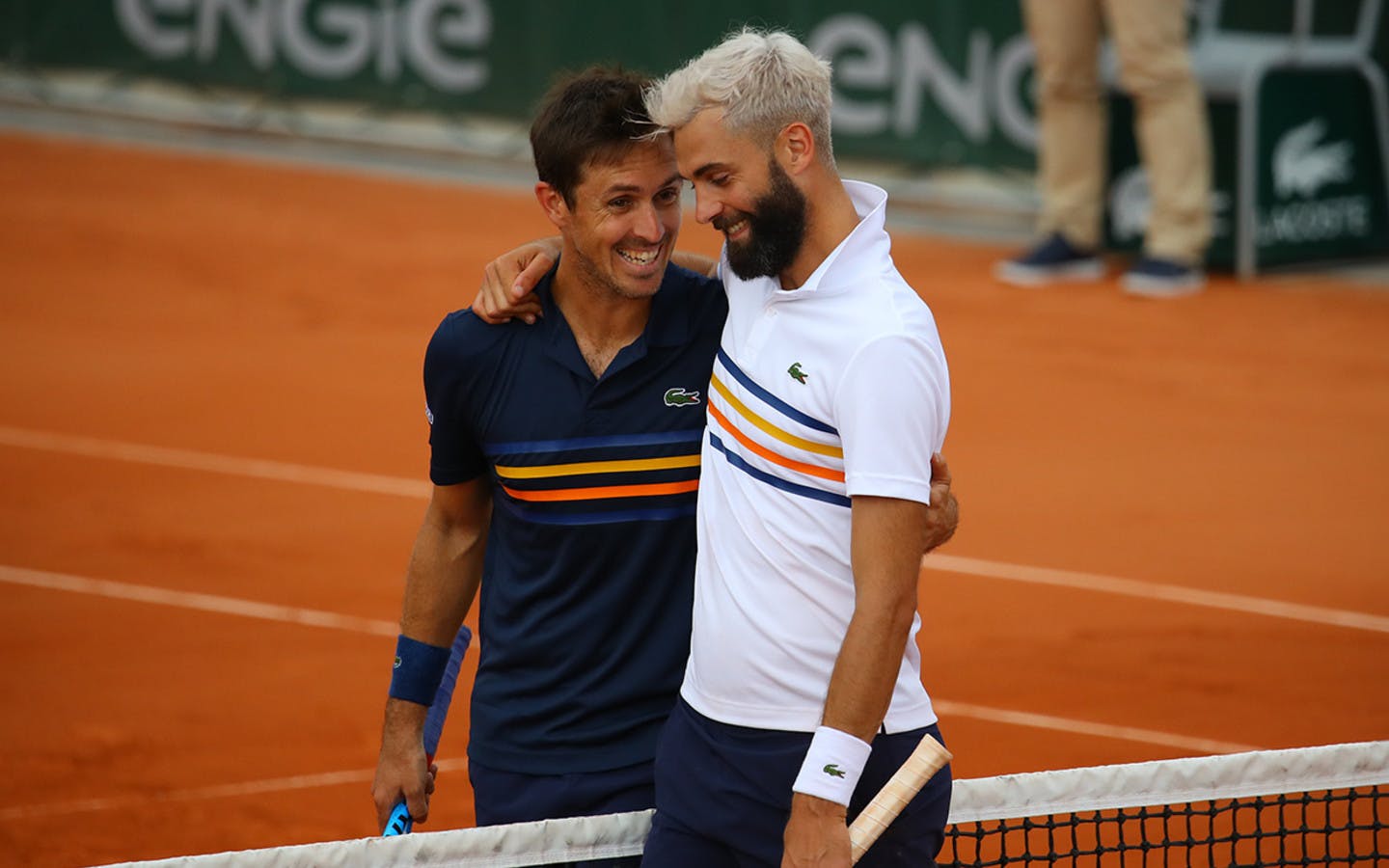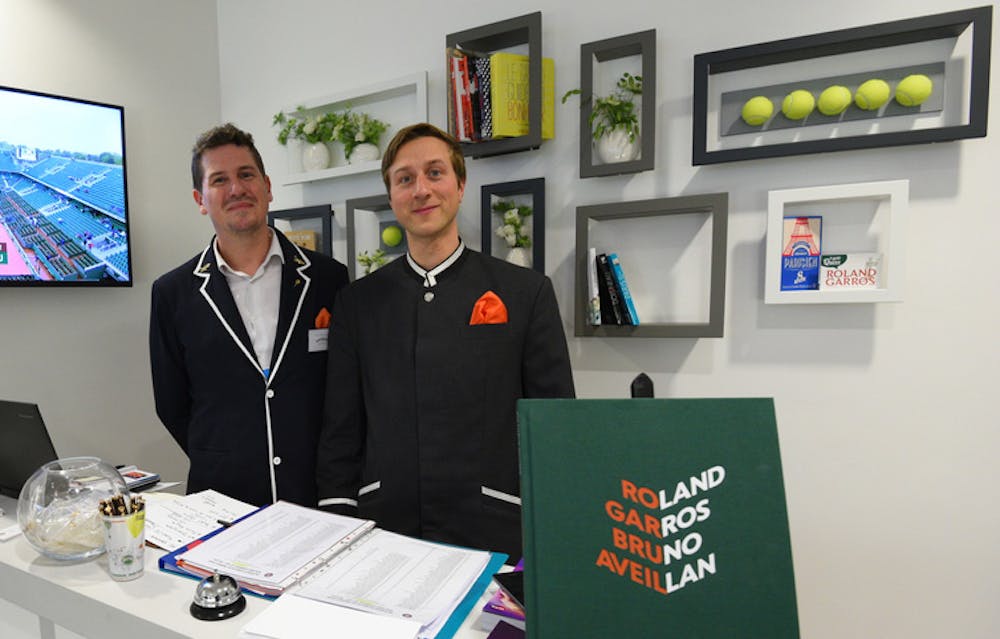Did you see?
Gallery: here for the handshake

The concierge and his chasseur, the Zverev bromance, and tales of juniors of all sizes ...

The concierge and his chasseur is one of the great doubles partnerships at Roland-Garros. As the official based in the players’ facilities on Court Philippe-Chatrier who fixes, organises, rescues and coordinates all sorts of services, Mikaël Loiselle is the go-to Monsieur Fixit for players during the tournament.
His assistant, le chasseur, which translates literally as “the hunter”, sits ready to jump on a scooter and whizz off to specialist shops or off-site services.
This year, a top-ranked player called on the first day with an SOS. The airline had lost his luggage, and he had nothing to wear beyond the clothes he had travelled in. “I called the airline and discovered the suitcase was in Switzerland. I explained it was very, very urgent that it was delivered to Paris,” he said. “The airline told me they could get it there by 6pm so I took the car myself in the rush hour to Charles de Gaulle, persuaded them to let me take the bag and at the end of my shift at Roland-Garros, at 11pm, I went to the players’ hotel to reunite him with all his clothes. He was very happy. He was just in jogging pants.”
Loiselle is too discreet to reveal the names of players he assists, but is happy to give rolandgarros.com a flavour of the kind of tasks he undertakes. On Monday, for example, he helped a player organise special treats for his wife’s birthday. “I bought a bouquet of roses for him to give her and I booked a table at the Café de l’Homme which overlooks the Eiffel Tower for a romantic dinner,” he revealed. “For another player, I arranged a table at Les Ombres, a restaurant on the rooftop of the Quai Branly Museum.”
When it comes to shopping recommendations, Loiselle advises the historic department store, Le Bon Marche. He also books tickets for the cabarets in Montmartre and the Champs-Elysees and trips on the bateaux-mouche on the Seine. His most unusual request this year has been to help players apply for visas to enable them to play at Wimbledon. The most popular? More mundane, it turns out. “Flocage,” he says. “To stick sponsors’ logos on to players’ kit. We take the clothes to a special store.”
Alexander Zverev’s exit ends the tongue-in-cheek bromance that began after the German’s second-round win. Sasha was stymied by the broad Yorkshire accent of journalist Jonathan Pinfield in his post-match press conference and uttered the now-famous soundbite, “Where are you from buddy?” This bromance looks set to run. Zverev’s departing chat to the media included this exchange:
Pinfield: My colleagues tell me I have become smitten by your tennis, but I assure them it's strictly professional.
Zverev: Is it?
Pinfield: Anyway, I have written you a poem. No, I haven't. Don't panic. I haven't. But for me, watching you on the court this week has been like watching poetry in motion sometimes. Tell us what have been your favorite and happiest memories of being at Roland Garros this week? What have you fallen in love with?
Zverev: The press conference after the second round was my favorite moment (laughter). I heard the Queen of England heard it. That's impressive. I think you're the only person who will actually make me smile right now.
Media Question: If we can just digress for a moment. Other people want to talk about tennis…
But the pair were not to be deterred.
Pinfield: Everyone loves a love story. I have had messages from people all around the world in the last week saying how much they have fallen in love with your tennis and your personality. I just want to exchange my thanks to you for all the love you have brought us on the court and off the court. And from me to you, I hope this is not good-bye; merely au revoir.
Zverez: I think you're going to get a CNN job or something for Wimbledon. I think they will hire you soon. So don't worry. I'll see you back.
Pinfield: I haven't got my pass for Wimbledon. I have missed the deadline. Let's see if we can make the magic happen, Sascha.
Zverev (grinning): All right. No worries.
There’s been a lot of baby and toddler talk, what with father-of-two Novak Djokovic trading parenting tips with Serena Williams, and the post-maternity return of Victoria Azarenka and Mandy Minella with special ranking status. How are the WAGs, HABs and children looked after at a busy tennis tournament?
“A Grand Slam is the only time you see a lot of families because the players are in one city for two or three weeks,” says Nathalie Dechy, the retired French three-times doubles champion whose role at Roland-Garros is head of player liaison. “That’s why we really want to take care of them. Day by day, with the scheduling, it is hard for them to plan their time. Rain is particularly tough for players’ families so we provide help with a concierge to advise outings to Disneyland Paris, Versailles or the Rodin Museum. I always recommend a trip to the Jardins d’Acclimatation on the north side of the Bois de Boulogne, where I used to go with my family when we were in Paris.”
It is a popular service. Loiselle, at the concierge desk, reveals he had 50 tickets for Disneyland at the outset; four days later he had none - but he has the contacts to organise alternative visits to the Parc Asterix.
The players’ facilities at Court Philippe-Chatrier are for main-draw players. The larger zone under Court Suzanne-Lenglen has more space for kids and buggies, and hosts a well-equipped crèche. “It’s not for babysitting kids all day long. It’s more of a drop-in for the duration of a player’s match,” says Dechy. “The goal is for the kids to socialise with other kids and leave Mum or Dad free to watch the match.” There is a second crèche at the training complex, and both also have TV screens so kids get a sense of their parent’s day job, and cheer them on. The Jean Bouin practice complex has been developed with more family-oriented facilities, so players enjoy more of a difference between the days they play and their days off.
As the junior singles events progresses to the quarter-final stages, rising stars such as the Sebastians Baez and Korda and Maria Camila Osorio Serrano and En Shuo Liang undoubtedly take inspiration from sharing the same competitive space as the world’s top-ranked players - and realising they are, in fact, following in some distinguished clay slides.
Five of the eight senior women’s quarter-finalists reached finals of junior Grand Slams on their way up the ladder. Simona Halep and Daria Kasatkina were junior Roland-Garros champions, the Romanian in 2008 and the Russian in 2014. In 2002, Maria Sharapova was runner-up in both the Australian Open and Wimbledon; in 2010, Yulia Putintseva was also runner-up at the US Open. Sloane Stephens, too, had a distinguished junior career; her CV boasts a 2008 US Open doubles finals appearance and a run to the 2009 Roland-Garros semi-finals.
Players develop at different rates, a fact emphasised perhaps by Dominic Thiem and Alexander Zverev’s junior Roland-Garros feats. Both reached the boys singles final, in 2011 and 2013 respectively, but were beaten by the American Bjorn Fratangelo (now ranked 109 in the world) and Christian Garin of Chile, who currently holds a world No.174 status.